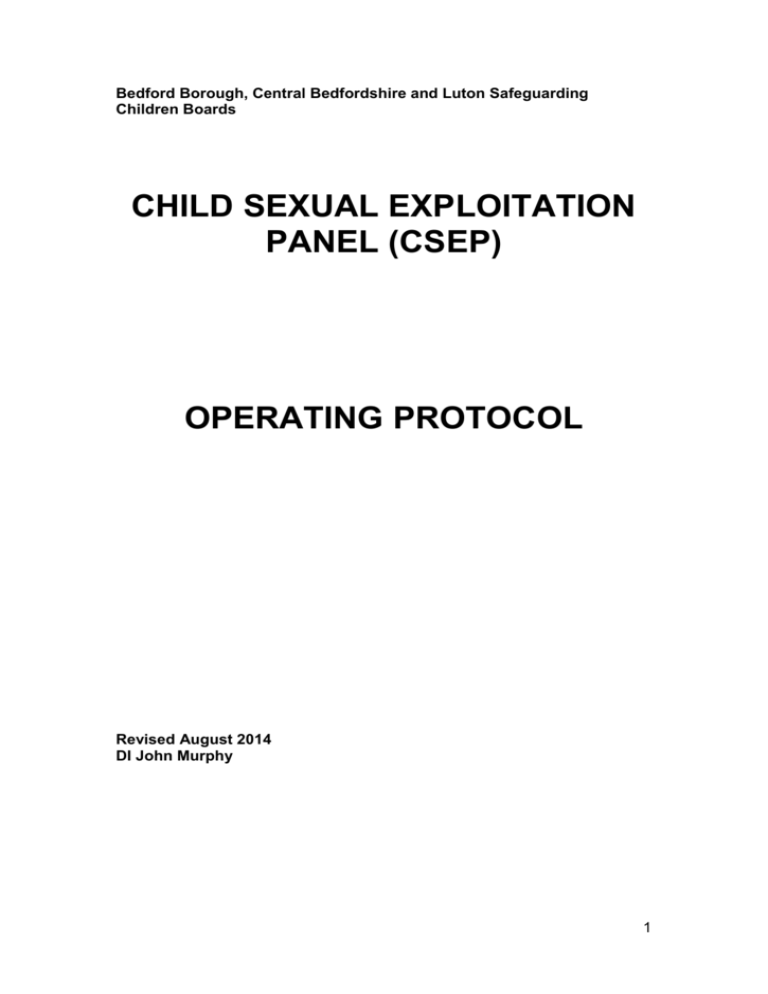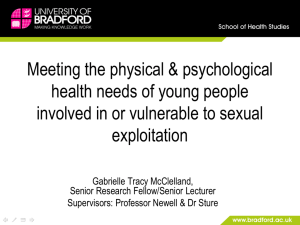
Bedford Borough, Central Bedfordshire and Luton Safeguarding
Children Boards
CHILD SEXUAL EXPLOITATION
PANEL (CSEP)
OPERATING PROTOCOL
Revised August 2014
DI John Murphy
1
Contents
1. Definition .................................................................................................. 3
1.1 Introduction............................................................................................. 3
1.2 What is a CSEP? .................................................................................... 3
1.3 Aims of the CSEP ................................................................................... 4
1.4 Schedule of Dates .................................................................................. 5
1.5 Location of Meetings .............................................................................. 5
2. The need for a Multi-Agency Approach .................................................... 5
2.1 Agency Attendance ................................................................................ 5
2.2 CSEP Representatives ........................................................................... 6
3. Governance, Performance Management and Evaluation ......................... 6
4. CSEP Referral Process ............................................................................ 6
4.1 Consent .................................................................................................. 6
4.2 Assessed risk level ................................................................................. 7
4.3 Referral Process..................................................................................... 7
4.4 Referral of repeat CSEP cases .............................................................. 7
4.5 Deadline for referrals .............................................................................. 8
4.6 CSEP List / Agenda ................................................................................ 8
4.7 Actions before the CSEP ........................................................................ 8
5. CSEP Meeting .......................................................................................... 8
5.1 CSEP Chair ............................................................................................ 8
5.2 Minutes and administration..................................................................... 9
5.3 Information shared at the CSEP ............................................................. 9
5.4 Action Planning ...................................................................................... 9
5.5 Completion of Actions............................................................................. 9
5.6 Observers ............................................................................................... 9
6. Other Information ................................................................................... 10
6.1 LADO (Local Authority Designated Officer) .......................................... 10
6.2 Equality................................................................................................. 10
6.3 Complaints ........................................................................................... 10
6.4 Breaches .............................................................................................. 11
6.5 Withdrawal............................................................................................ 11
2
1. Definition
In this document the terms, ‘young people’, ‘children’ or ‘child’ refers to people under
18 years of age, both male and female. The fact that a child has reached the age of
16 or is living independently does not change his or her status or entitlement to
services or protection under the Children Act 1989.
The sexual exploitation of children and young people is a form of child sexual abuse.
Working Together to Safeguard Children (2013) describes sexual abuse as follows:
(NB – The definition has been bullet pointed to aid understanding)
Sexual abuse involves forcing or enticing a child or young person to take part in
sexual activities, not necessarily involving a high level of violence, whether or not
the child is aware of what is happening.
The activities may involve physical contact, including assault by penetrative (e.g.
rape or oral sex) or non –penetrative acts such as masturbation, kissing, rubbing
and touching outside of clothing.
They may also include non-contact activities, such as involving children in looking
at, or in the production of, sexual images, watching sexual activities, encouraging
children to behave in sexually inappropriate ways, or grooming a child in
preparation for abuse (including via the internet).
Sexual abuse is not solely perpetrated by adult males. Women can also commit
acts of sexual abuse, as can children
Sexual exploitation of children and young people under 18 involves exploitative
situations, contexts and relationships where young people (or a third person or
persons) receive ‘something’ (e.g. food, accommodation, drugs, alcohol, cigarettes,
affection, gifts, money) as a result of them performing, and/or another or others
performing on them, sexual activities. Child sexual exploitation can occur through the
use of technology without the child’s immediate recognition; for example being
persuaded to post sexual images on the Internet/mobile phones without immediate
payment or gain. In all cases, those exploiting the child/young person have power
over them by virtue of their age, gender, intellect, physical strength and/or economic
or other resources. Violence, coercion and intimidation are common, involvement in
exploitative relationships being characterised in the main by the child or young
person’s limited availability of choice resulting from their social/economic and/or
emotional vulnerability.
1.1 Introduction
The aim of this protocol is to outline the processes of the countywide Child Sexual
Exploitation Panel (CSEP).
This document will detail the responsibilities of all parties involved in the CSEP, their
accountability and local reporting structures. It is however recognised that the CSEP
is an evolving process and as such this will be under constant review.
The overall intention of this protocol is to encourage greater awareness and
confidence in the CSEP process, and as a consequence to improve the engagement
of all partner agencies in order to increase the safety and access to services of
children and young people who are or might be victims of sexual exploitation living in
Bedfordshire and Luton.
1.2 What is a CSEP?
In November 2011 the Government published the Tackling Child Sexual Exploitation
action plan which was developed in the context of the Munro review of child
3
protection. Like Professor Eileen Munro’s final report, and the Government’s
response to her review, the action plan emphasises the important role of LSCBs at
the centre of local multi-agency arrangements to help and protect children and young
people.
To address the following parts of the action plan;
The LSCB’s map the needs of their own area to identify levels of child sexual
exploitation and locations or circumstances where children are particularly at
risk (and repeat the exercise periodically);
The LSCB’s to put in place systems to monitor on-going prevalence and
responses to child sexual exploitation within their area, making use of existing
monitoring tools like the one developed by the University of Bedfordshire if
they find it helpful to do so;
The LSCB’s to ensure that agencies safeguard and promote the welfare of
groups of children who are potentially more vulnerable than others and are at
increased risk of child sexual exploitation, by:
Establishing effective communication channels between the LSCB and
partner agencies, including specialist services which have an important role to
play;
The LSCB’s to develop links with neighbouring authorities and meet them on
a formal basis and as required where there are cross border concerns.
Bedford, Central Bedfordshire and Luton have decided to implement the CSEP
process locally, with a trial indicating the need for this approach to continue. The
CSEP will follow the process and principles of the SARAC (Sexual Assault Risk
Assessment Conference) model which recognises the differences in the needs and
concerns of victims of rape and sexual assault.
Following this model a CSEP is a multi-agency meeting which has the safety of local,
high risk victims of sexual exploitation as its focus. It involves the participation of key
statutory and voluntary sector agencies involved in supporting children and young
people who are or might be victims of sexual exploitation. This includes those from
the criminal justice system, many different parts of the health service, the local
authority, housing providers, substance misuse agencies. Other agencies outside of
the normal safeguarding arena will he invited as appropriate for example Health and
Safety, Licensing, etc.
Unlike the MARAC which is a high volume process, reflecting the prevalence of
domestic abuse in every community, it is expected that the CSEP process will
identify and work with a much smaller number of cases.
1.3 Aims of the CSEP
The stated aims and objectives of the CSEP process are to:
Share relevant information to increase the safety, health and wellbeing of
children and young people;
Make links with other public protection arrangements in relation to children,
young people and perpetrators.
4
Determine whether the perpetrator (where known) poses a significant risk to
any particular individual or to the general community;
To disrupt the activities of identified perpetrators
To aid the prosecution of identified perpetrators
Construct jointly and implement a risk management plan that provides
professional support to all those at risk and that reduces the risk of harm;
Reduce repeat victimisation;
Reduce serial perpetration;
Improve agency accountability; and
Improve support for and the safety of staff involved in working with children
and young people who are or are possibly being sexually exploited.
1.4 Schedule of Dates
The county-wide CSEP will commence on March 13th 2013 and meetings will be held
on the following dates, unless the meeting has previously agreed an alternative date,
perhaps due to public holidays etc. Please see appendix B for more information
1.5 Location of Meetings
The venue is agreed by all members and remains the same unless alternative
arrangements are necessary, should this be the case, all members will be informed
via email.
2. The need for a Multi-Agency Approach
Within the context of sexual exploitation it is recognised that no one partner holds all
the information required to effectively assess the needs or fully assess the risk of
serious harm to children and young people. Also in the majority of cases the support
of more than one agency is required to ensure the longer term safety and support of
children and young people. The CSEP enables the available information to be shared
across relevant partner agencies, resulting in a clearer picture of the risk level. This
also supports a more comprehensive action plan to be developed to reduce the risk
of harm and the level of support offered to children and young people.
2.1 Agency Attendance
The CSEP process will invite representation from all agencies which have a role to
play in increasing children and young people’s safety including non-criminal justice
agencies. In recognising the sensitive nature of the information to be shared at CSEP
it is anticipated that representatives will be invited according to the needs of
individual cases.
Therefore whilst the CSEP will require the attendance of representatives from the full
range of statutory agencies and relevant voluntary and community organisations in
order to achieve its stated aims, it is not expected that all representatives will attend
the full duration of each meeting. Representation at the CSEP is anticipated from the
following partners;
Bedford Borough Council
-Anti Social Behaviour Team
-Children’s Social Care
-Education Welfare
Bedford Hospital NHS Trust
Bedfordshire Police
Bedfordshire Youth Offending Service
Brook Bedfordshire
5
Brook Luton
Central Bedfordshire Council
-Anti Social Behaviour Team
-Children’s Social Care
-Education Welfare
Luton and Dunstable Hospital NHS Trust
Luton Borough Council
-Anti Social Behaviour Team
-Children’s Social Care
-Education Welfare
Luton Youth Offending Service
NHS Bedfordshire (including GU Service)
NHS Luton (including GU Service)
SEPT Mental Health
2.2 CSEP Representatives
CSEP representatives from the agencies should be of an appropriate level of
seniority to commit to actions on behalf of their agencies. Consistency of attendance
is strongly encouraged to reinforce and develop practical working relationships.
The CSEP Representative is also the Single Point of Contact for relevant data
collection and management purposes for most partner agencies.
If a CSEP representative is unable to attend then the representative should inform
the CSEP Chair in advance of the meeting and provide a written submission of
relevant information.
3. Governance, Performance Management and Evaluation
The strategic responsibility for the CSEP falls within the remits of the Safeguarding
Children Boards within each area and the Child Sexual Exploitation Strategic Group.
4. CSEP Referral Process
A key underpinning principle of CSEP is that any agency can identify and refer cases
to the process. All partner agencies are encouraged to establish awareness training
to educate staff around screening for child sexual exploitation. This will ensure that
children and young people are identified at the earliest possible stage, irrespective of
which agency they may interact with.
4.1 Consent
All children and young people must be advised of the CSEP but their consent for
their case to be referred to the CSEP is not required as these referrals will be made
under child protection thresholds.
All agencies should:
Encourage the child or young person to report the abuse to the Police where
they have not already done so.
Signpost locally available support services where appropriate
Notify Children Social Care of the referral if the child or young person has not
already been referred to them.
6
4.2 Assessed risk level
A risk assessment tool has been developed in Bedford Borough, Central
Bedfordshire and Luton using the Derby Risk Assessment Toolkit. In adopting this
toolkit it is recognised that this is an evolving area of work and it is anticipated that
amendments will be made to the assessment tool over time.
The indicators in the toolkit are a guide and should assist the exercise of professional
judgment. Completion of the Risk Assessment by the professional identifying the
concerns should involve liaison with other agencies to enable multi-agency
information sharing and support.
The tool does however provide a framework within which professionals can consider
known risk factors in relation to child sexual exploitation and provides a guide as to
appropriate thresholds for referral to CSEP.
A copy of the Risk Assessment toolkit is included as Appendix B.
4.3 Referral Process
Any partner agency can refer a case to the CSEP if they believe a child or young
person is at risk of or are being sexually abused through exploitation. If an agency
believes that a case is high risk then a referral is made to Children Social Care
following the completion of the Risk Assessment toolkit.
The referral form to the CSEP can be found at Appendix A. The Risk
Assessment (see Appendix B) should be completed before submitting the
CSEP referral and the level of risk identified added to the referral form.
Referrals for Luton and Bedford Borough should be forwarded to
CSEpanel.bedfordshire@luton.gcsx.gov.uk and copy to
Deborah.lawson@luton.gcsx.gov.uk
Referrals for Central Bedfordshire should be forwarded to
SERAC@centralbedfordshire.gcsx.gov.uk
4.4 Referral of repeat CSEP cases
Should a child or young person be referred into the CSEP on more than one
occasion, the actions from the initial meeting shall be tabled at the repeat discussion.
This is to look back on the actions agreed, what has been successful for that child or
young person & to identity any gaps in the plan moving forwards.
All CSEP repeat cases are a consequence of at least one incident being reported to
at least one CSEP agency and that the incident involves:
Either a further sexual offence has been disclosed or concerns have been
raised about the child or young person’s behaviour that would indicate that
they are or could be being sexually abused through exploitation
Violence or threats of violence from the known perpetrator and/or
Repeat patterns of behaviour by a child/ren young person and/or
Reports of children and young people visiting an address/establishment
N.B. The repeat incident can be flagged by any of the agencies involved in the
CSEP.
It is possible for a case to go to CSEP where there is more than one perpetrator. This
is counted as one case and will be reviewed if there are any incidents with any of the
7
named perpetrators. This is due to the fact that the CSEP would count each child or
young person as one case.
The following do not constitute a repeat case:
• Where a case is reviewed at the CSEP involving the same child or young person
but a different perpetrator or group of perpetrators
• Where a case is reviewed at the CSEP involving the same perpetrator but a
different child or young person.
4.5 Deadline for referrals
Referrals for inclusion in the CSEP must be submitted by the deadlines identified in
Appendix B. Referrals received after that date will be held over to the next CSEP
meeting unless the case require a more urgent response in which case an
emergency CSEP meeting may be required (see section 4.6 below)
4.6 CSEP List / Agenda
The CSEP list of cases will be officially circulated by secure email a week before the
meeting so that all agencies are provided with an opportunity to complete their
research before the meeting.
If an urgent case is submitted after the deadline, it may be added to the agenda but
this would only be done when the circumstances require immediate action.
Alternatively an emergency CSEP may be arranged.
The list and timings shall be circulated with the case list to inform partners of case
timings.
4.7 Actions before the CSEP
It is not intended to be the case that agencies wait until the CSEP meeting before
taking action to address a case and begin reducing risk. Prior to the meeting work will
commence within a number of agencies to address issues of safety and support.
These are likely to include:
Safeguarding Children and young people - There may also be a need for
immediate safeguarding actions in cases where children or young people are
involved. A strategy meeting will be initiated if necessary with Children Social
Care.
5. CSEP Meeting
5.1 CSEP Chair
The CSEP meeting is chaired by a representative of Bedfordshire Police, on a
rotation basis with representatives of Bedford Borough, Central Bedfordshire and
Luton authority areas.
In the event that the Chair is unable to attend a CSEP meeting, discussion will take
place between key members of the panel in order to identify a suitable replacement.
Ideally this will take place in advance of the day.
The role of the CSEP Chair is:
To structure the meetings.
To review outstanding actions.
To ensure that all agency representatives are able to share information
known to their agency about the client.
To facilitate the development of a multi-agency support plan.
8
To ensure that all agency representatives understand their agreed actions.
5.2 Minutes and administration
The Luton Community Safety Partnership will administer the CSEP and the minutes
will be prepared and circulated to all members within 5 working days of the meeting.
5.3 Information shared at the CSEP
All agencies are signed up to the Safeguarding Children Boards Information Sharing
protocol. The nominated CSEP representative for each agency will be the main
contact for all relevant information.
5.4 Action Planning
Within the CSEP meeting actions will be developed to increase the safety of the
child/ren or young person, other vulnerable parties and any staff and disrupt the
activities of the perpetrator. It is a key principle of the CSEP process that actions are
specific to individual cases so as to address the particular circumstances and wishes
of the victim.
Examples of Actions may include:
Referral to specialist services and providers of support.
Referral to other appropriate multi-agency meetings or out of areas services,
or agencies as required and appropriate.
Liaison between agencies pre / post actions.
Providing feedback to the victim on the CSEP process.
It is expected that agencies will volunteer actions and it is not the role of the CSEP
Chair to allocate actions to participating agencies.
5.5 Completion of Actions
The CSEP Chair will query any outstanding actions if these have not been completed
by the date of the next meeting. It remains however the responsibility of the named
agency to ensure that actions are completed in a timely fashion.
Where agencies are unable to complete either individual or standard actions they
should in the first instance notify the CSEP chair. The role of the CSEP is to facilitate,
monitor and evaluate effective information sharing to enable appropriate actions to
be taken to increase public safety. The responsibility to take appropriate action rests
with individual agencies; it is not transferred to the CSEP.
5.6 Observers
It is recognised that the CSEP approach is new and is likely to be of interest to many
partners both locally and across the country. Consequently it is acknowledged that
there is a high likelihood that request to observe the process may be received from
partners across various agencies.
While we are keen to promote the work of the CSEP and to encourage partners to
contribute to such multi-agency initiatives we are nonetheless aware of the highly
sensitive nature of the information shared within CSEP meetings.
For this reason it is considered inappropriate to allow observers to attend the CSEP
meetings unless there are warranted reasons for the need for an observer to attend.
In such cases agencies will be required to comply with the following:
9
1. The agency who has invited the observer takes full responsibility for the
observer, briefing them beforehand on the confidentiality requirements of the
CSEP.
2. All CSEP partner agencies are advised before the meeting of the proposed
observer and given an opportunity to agree or not to the observer attending
the meeting.
6. Other Information
6.1 LADO (Local Authority Designated Officer)
All agencies should be aware of additional actions required when dealing with
allegations towards staff or volunteers working with children and young people.
LADO guidance should be followed in respect of any allegation that a person who
works with children and young people has:
behaved in a way that has harmed, or may have harmed a child or young
person;
possibly committed a criminal offence against or related to a child or young
person; or
Behaved towards a child/ren or young people in a way that indicates s/he is
unsuitable to work with children and young people.
If concerns arise about the person’s behaviour in regard to his/her own children, the
Police and/or Children Social Care need to consider informing the person’s employer
in order to assess whether there may be implications for children with whom the
person has contact at work. (I.e. a case that has been listed at CSEP)
For further information concerning the LADO role can be found in Working Together
2013.
6.2 Equality
Bedfordshire and Luton has a very culturally diverse population. All partner agencies
are committed to delivering services that meet the needs of all residents.
6.3 Complaints
Any CSEP signatory agency wishing to make a complaint against another signatory
agency related to the CSEP must follow the procedure as set out below.
Anyone who wishes to make a complaint may do so in person, by telephone,
or in writing (by letter, fax or e-mail.) Written complaints can be submitted by
mail, fax or email.
In the first instance all complaints are to be made to the CSEP Chair, The
CSEP Chair will acknowledge receipt of the complaint within 5 working days
and provide a timeframe in which a response will be made.
The CSEP Chair in conjunction with the other members of the CSEP (where
appropriate) will investigate the complaint, consider a response and write to
the complainant offering an explanation / list of reasons / facts of all issues
and concerns.
If the complainant is not satisfied with the initial response from the CSEP
Chair then an escalated letter of complaint can be sent to the chair of CSE
Strategic Group.
Receipt of the complaint will be acknowledged within 5 working days and
responded to within a stated time frame. Where possible the response should
10
be reviewed by the Pan Bedfordshire CSE Strategic Group or the relevant
Community Safety Partnership group (Luton)
If a complaint relates to a member of staff and cannot be dealt with through
the process above, then the complaint will be referred back to the employing
agency who will be asked to deal with the complaint under their own internal
Complaints Procedure.
6.4 Breaches
This Operating Protocol is intended to provide a framework for the Bedfordshire and
Luton CSEP and to ensure the effectiveness of the CSEP process. The intention of
the CSEP, the Information Sharing Protocol and this Operating Protocol is to
increase the safety of the victim. All agencies are advised to ensure they operate
within these protocols as a breach may increase the risk to an already high risk
victim. Any identified breaches of either the Operating Protocol or Information
Sharing Protocol, will be referred to the relevant LSCB for consideration.
6.5 Withdrawal
CSEP partner agencies are required to sign both the Information Sharing Agreement
and the CSEP Operating Protocol. If any agency wishes to withdraw their agreement
to this Operating Protocol they must, in the first instance, advise the CSEP Chair of
their decision. It is the responsibility of the CSEP Chair to bring this to the attention of
the Pan Bedfordshire Strategic Group for them to agenda this item for further
discussion.
11
Appendix A
Bedford Borough, Central Bedfordshire and Luton Borough
Child Sexual Exploitation Panel (SERAC)
Referral and Intelligence Reporting Form
For advice on how to complete and submit this form securely please read the accompanying
Child Sexual Exploitation Panel, Referral Guidance Notes (Appendix One)
If a Child is at immediate risk or Urgent action is needed, please contact 999 or 101
CSE Panel Referral?
Yes
No
If the case relates to the Luton or Bedford Council area please send to
CSEpanel.bedfordshire@luton.gcsx.gov.uk and copy to
Deborah.lawson@luton.gcsx.gov.uk
If the case relates to the Central Bedfordshire Council area please send to
SERAC@centralbedfordshire.gcsx.gov.uk
Police Intelligence Report?
Yes
No
If yes please provide the a unique reference number for the child/young person e.g. NHS number,
social care client number or pupil number
Unique Reference Number ………………………………………………………..
and send to CIBintel@bedfordshire.pnn.police.uk
Section One: Summary Details
Details
Child/Young Person Name
Child/Young Person DOB
Area of residence
Referring Agency
Lead Professional
Professional Contact
Age
12
Section Two a: Professional Details
Name of professional
Post/Job Title
Agency
Contact details (address,
telephone number and email
address)
Date and time form
completed
Witnessed Incident
Level of risk identified
By a
member
of the
public
Low
By a
Professional
Medium
By
another
child or
young
person
High
Section Two b:
Details about the Child(ren) /Young person(s) at Risk. (If there are more than one
child/young person, please copy the following section and complete for each additional
child/young person).
Name of child or young person
DOB or approx age
Address and telephone number
Parent/Guardian/Carer: Names, dob and
contact details
Are they aware of the concerns?
School/College/Educational Establishment:
Names and contact details
Are they aware of the concerns?
Friends/Associates: Names and contact details
Are they aware of the concerns?
Status of case
CAF
Section 17
Section 47
Subject to a Child Protection Plan
Looked after Child
Description of the child/young person
Hair:
Dark brown
Ethnicity: Pakistani
Height:
Approx 5ft 8-10
Clothes: Wears trainers
Jewellery:
Distinguished markings (e.g. tattoos):
Accent (even if not sure, state there is one):
Nicknames:
Mobile Phone Activity
Time of calls
Age
Please tick as appropriate
Skin:
Build:
13
Frequency of calls
Number of callers
Behaviour of child/young person post call
(angry, upset, leave the unit immediately?)
Appearance when child/young person was last
seen:
Who is the child/young person known to be with:
Date & time last seen:
Length of absence:
Frequently staying out late at night without
explanation:
Episodes of running/ going missing
Persistently going missing from placement/home
Missing patterns
Emotional & Physical appearance upon
return
Section Three:
Details about the person presenting a risk to a Child/Young Person (If there are more than
one person posing a risk then please copy the following section and complete for each
additional person)
Name:
Date of Birth or approx. age
Address or location:
Telephone number
Description of the person presenting the risk:
Hair:
Skin:
Ethnicity:
Height:
Clothes:
Jewellery:
Distinguished markings (e.g. tattoos):
Accent (even if not sure what it is)
Nicknames:
Employment
Associates
How are they communicating with the
child/young person?
Cars being used to visit/collect/transport the
child/young person
Model (s)
Colour (s)
Number Plate (s)
Section Four: Overview of Background and Risk
Please provide here;
A summary of the background of the case
What are your concerns about this child/young person?
What actions have already been undertaken?
What services have been commissioned?
14
If relevant, do you know that it is illegal to have sex under 16 years? (it is statutory rape for under
13 years) YES
If yes, does the young person understand the issues and implications? YES
If relevant, has this been discussed with the young person? YES
Name(s) and contact details of persons/professionals this information has been shared with:
Appendix ONE
Bedford Borough, Central Bedfordshire and Luton Borough
Child Sexual Exploitation Panel
Referral and Intelligence Reporting Form – Guidance Notes
1. Where to send referrals and/or intelligence reports
If a Child is at immediate risk or Urgent action is needed, please contact 999 or 101
To submit a referral to the Child Sexual Exploitation Panel, please fully complete the referral and
intelligence reporting form and send the referral by secure email to:
CSEpanel.bedfordshire@luton.gcsx.gov.uk
and / or
To submit an intelligence report to Bedfordshire Police please provide the child or young persons
unique reference number (e.g. their NHS number, social care client number or pupil number) and
send via secure email to:
CIBintel@bedfordshire.pnn.police.uk
Please title your email Child Sexual Exploitation. This email address is monitored between 0700 and
1700 daily. If urgent and out of hours, please contact 999 or 101
2. Completing the Form
Please complete the form as thoroughly as possible. If you do not have sufficient information to
answer a question please leave it blank. Please do not guess answers to any of the questions.
Please include as much information as you are able to provide.
15
3. Sending Referrals Securely
All information about children and young people should be sent by electronic means where possible.
Paper based information should where possible be scanned and attached to secure emails. Care is
needed in sending copies of correspondence and also forwarding e-mails as these could often
include a “trail” of linked emails which could contain sensitive items.
Always type “Confidential” in the subject line as this will ensure emails that are forwarded out of the
organisation are automatically encrypted if appropriate. Personal identifiable data must never be
included in the subject line.
When sending personal information, it is the responsibility of the sender to ensure that they are
sending to the correct person, therefore always check recipient details carefully.
Not all email addresses are secure.
Although the CSE Panel and Bedfordshire Police intelligence email addresses are both secure,
information is only secure if it is also sent from a secure email address, like the ones identified
below;
nhs.net
gsi.gov.uk
gsx.gov.uk
gse.gov.uk
pnn.gov.uk
scn.gov.uk
pnn.police.uk
gcsx.gov.uk
gsisup.co.uk
cjsm.net
psops.net
sms.nhs.net
To Password protect the form if you do not have a secure email address as above follow these
simple steps;
1. When you have completed the form go into Tools then select options and then security where
you will be asked to type in a password. This will mean that the document cannot be opened
without someone typing in your password.
2. You email the document protected by the password to the recipient as an attachment.
3. You communicate the password to the recipient by some other means, preferably not by email,
and certainly not within the email to which you attached the encrypted document.
4. The recipient uses the password to decrypt the document.
This form is for sharing information that may assist in the prevention, disruption or prosecution of
Sexual abuse of children and young people through exploitation, but that does not alone relate to a
child protection issue or a criminal offence. Submission of this form does not replace the duty to
refer child protection concerns, or to report a crime.
The information sharing levers relevant to use of this form are contained in: The Crime and Disorder
Act 1989 (prevention and detection of crime); and, The Data Protection Act 1988 (prevention and
detection of crime and/or apprehension of offenders; and, protection of personal data). Under the
provisions in the above acts, it is not necessary to obtain consent to share relevant information.
Sexual abuse of children and young people through exploitation is a crime, as set out in the Sexual
offences Act 2003; and is a child protection issue as set out in the Children Act 1989. For the
purposes of both acts, an individual is a child up to their 18thbirthday.
16
If you have a concern relating to safeguarding children, you should follow the interagency
child protection procedures at;
http://bedfordscb.proceduresonline.com/index.htm
If you want to report a crime, you should contact the police on either 999 (emergency) or 101
(Police national non-emergency number)
If you have information to share then please advise your line manager or designated lead for
safeguarding. Agree the nature of the information (i.e. is it a safeguarding concern, related to a
criminal offence – if either of these, see above) and, if it is information related to possible sexual
abuse of children and young people through exploitation, agree who will complete and submit the
form. If there may be a safeguarding concern and/or an issue related to a possible criminal offence,
you should seek further advice from the relevant agencies and if agreed make a referral or report as
appropriate.
17
Appendix B
The Risk Assessment Tool (NB – This should be used as a guide only and does not replace professional Judgement)
Name of Young Person:
Name of Person Completing:
Agency:
RISK LEVEL
Low Risk
Low risk cases that do not
meet the threshold for
Children Social Care
intervention should have
received individual or
multi-agency intervention
through the CAF and be
referred to a Sexual Abuse
of children and young
people through
Exploitation meeting.
RISK
INDICATORS
These maybe
indicators of
sexual abuse
of children
and young
people
through
exploitation
ONE OR MORE
INDICATORS
IDENTIFIED
DOB:
Date:
BEHAVIOURS & UNDERLYING
VULNERABILITY FACTORS
Regularly coming home late or going
missing
Overt sexualised dress
Sexualised risk taking including on the
internet
Unaccounted for monies or goods
Associating with unknown adults or other
sexually exploited children
Reduced contact with family/friends
Sexually transmitted infections
Experimenting with drugs/alcohol
Poor self-image, eating disorder, some
self-harm
Witnessing/experiencing domestic violence
Children and young people ‘Looked After’
Patterns of abuse and/or neglect in family
Homelessness/sofa surfing
Substance misuse by parents/carers/child
Learning disabilities, special needs or
mental health issues
REQUIRED ACTION
Ensure ALL information is recorded.
Complete CAF and/or consider a
referral to Children Social Care.
Make appropriate referrals for sexual
health and/or relationship counselling.
The child or young person is to be
assessed for changes to risk status
every 4-6 weeks using the risk matrix
until the child or young person is safe
or the risk is removed.
If risk is escalating follow the
procedures below for Medium or High
Risk cases.
Refer the case to CSEP (Sexual
Exploitation Risk Assessment
Conference) to share intelligence and
develop disruption strategies.
18
Homophobia
Breaks in adult relationships
Death, loss or illness of a significant
person in the child’s life
Financially unsupported
Some form of family conflict
Lack of love and security
Adult soliciting (prostitution)
Notify Police at
missingpersons@bedfordshire.pnn.poli
ce.uk if the child or young person is
missing from Home or Care
Keep detailed records of incidents
using this risk assessment and the
information sharing template and email
to CIBintel@bedfordshire.pnn.police.uk
to share information on
victims/perpetrators and/or ring the
Police Central Intelligence Bureau on
01234 842757
No child under 13 can be
categorised as LOW.
Migrant/refugee/asylum seeker
No child with a learning disability
OR Mental Health concerns can be
categorised as LOW.
No Looked after child or young person
can be categorised as LOW
No leaving and After Care young
person can be categorised as LOW
19
20
RISK LEVEL
Medium Risk
As indicated above, the
indicators are a guide to
assisting the exercise of
professional judgement.
In relation to the
medium level indicators,
should professional
judgement determine
that there is reasonable
cause to suspect that
the child is suffering or
likely to suffer significant
harm requiring
investigation under S47
of the Children Act, then
the procedures detailed
under the higher level of
risk should be followed.
RISK
INDICATORS
These maybe
indicators of
sexual abuse
of children
and young
people
through
exploitation
Any of the
above AND
ONE OR MORE
INDICATORS
IDENTIFIED
BEHAVIOURS
Getting into cars with unknown or known
adults who sexually abuse children and
young people through exploitation
Being groomed on internet
Clipping i.e. offering to have sex with the
intention of robbing the victim, then running
before sexual activity
Disclosure of physical assault with no
substantiating evidence to warrant a S47
enquiry, followed by withdrawal of
complaint
Reports of involvement in child sexual
abuse through exploitation such as seen in
hot spots
Older boy/girlfriend
Non school attendance or excluded
Staying out overnight with no explanation
Breakdown of placements due to behaviour
Unaccounted monies or goods i.e. mobiles,
drugs, alcohol, clothing
Multiple sexually transmitted infections
Self-harming requiring medical assistance
REQUIRED ACTION
Take whatever steps are required to
protect the child or young person, i.e.
Emergency Protection Order, Police
Protection Order or staying with a
family member in another area.
Refer to Children’s Social Care via the
Intake and Assessment Team/Referral
& Assessment team for S47 enquiries.
If already known to Children Social
Care then contact the allocated Social
Worker and/or their Team Manager.
Strategy meeting is held under
Interagency Child Protection
Procedures where appropriate.
If not a S47 enquiry, then if not
already completed a CAF to be
undertaken within 10 working days
and presented at the CSEP. Where
there is a service specific assessment
such as ASSET in place, then this
should be updated and the additional
information used to inform presentence reports. The completed
CAF should be sent prior to the CSEP.
Notify Police at
missingpersons@bedfordshire.pnn.poli
ce.uk if the child or young person is
missing from Home or Care
21
Repeat offending
Make appropriate referrals for sexual
health and/or relationship counselling.
Collate and share information on any
perpetrators, hotspots and
associations involved with the young
person.
Establish regular core group and refer
case to CSEP until child/young person
is protected or desists from risk taking
behaviours.
Gang association or membership
Employ immediate disruption tactics;
see disruption toolkit which can be
found in Practice guidance and risk
assessment tool for children and
young people sexually abused
through exploitation http://www.bedfordshirelscb.org.uk/
publications
Keep detailed records of incidents
using this risk assessment and the
information sharing template and email
to CIBintel@bedfordshire.pnn.police.uk
to share information on
victims/perpetrators and/or ring the
Police Central Intelligence Bureau on
01234 842757
22
RISK LEVEL
RISK
INDICATORS
BEHAVIOURS
Child under 13 engaging in sexual activity
High Risk
It is envisaged that the
use of an Initial Child
Protection Conference
(ICPC) in cases of child
sexual abuse through
exploitation will be
become more widely
used, especially where
there are a number of
other concerns
alongside the sexual
exploitation, in particular
neglectful or collusive
parenting.
These maybe
indicators of
sexual abuse
of children
and young
people
through
exploitation
Any of the
above and
ONE OR
MORE OF
THESE
INDICATORS
Pattern of street homelessness and
staying with an adult believed to be
sexually exploiting them
Child under 16 meeting different adults
and exchanging or selling sexual activity
Removed from red light districts by
professionals due to sexual abuse through
exploitation
Being taken to clubs and hotels by adults
and engaging in sexual activity with adults
Disclosure of sexual assault and then
withdrawal of disclosure/statement
Abduction and forced imprisonment
REQUIRED ACTION
As above and;
Referral to Children Social Care Intake
and Assessment Team/Referral &
Assessment team
Initial Child Protection Conference and
CSEP convened depending on factors
surrounding the child or young person.
Police discussion re Immediate S47
Joint Investigation Enquiry.
Regular review under Child Protection
or Children in Need. Case presented
at CSEP to ensure that the child/young
person is protected from abuse.
Police to liaise with Crown Prosecution
Service for evidential thresholds for
23
Disappearing from the system with no
contact with support
Being bought/sold/ trafficked
Multiple miscarriages and terminations
Indicators of sexual abuse of children
and young people through exploitation in
conjunction with chronic alcohol and drug
use
Indicators of sexual abuse of children
and young people through exploitation
alongside serious self-harming
Receiving a reward for recruiting other
peers to sexual abuse of children and
young people through exploitation
prosecution.
In discussion with the Police Employ
immediate disruption tactics; see
disruption toolkit which can be found in
the Practice guidance and risk
assessment tool for children and
young people sexually abused
through exploitation http://www.bedfordshirelscb.org.uk/
publications
Keep detailed records of incidents
using this risk assessment and the
information sharing template and email
to CIBintel@bedfordshire.pnn.police.uk
to share information on
victims/perpetrators and/or ring the
Police Central Intelligence Bureau on
01234 842757
NOTE: A child with a Learning
Disability or Mental Health issue must
be considered as HIGH risk
A child under 13 years must be
considered as HIGH risk
24
Appendix C
CSEP Dates and Venue for 2014
Venue details; Central Bedfordshire Council, Priory House, Monks Walk, Chicksands,
Shefford (the postcode for a Sat Nav's is SG17 5XY)
Date
Venue
Times
15th January 2014
12th February 2014
12th March 2014
9th April 2014
14th May 2014
11th June 2014
9th July 2014
13th August 2014
10th September 2014
8th October 2014
12th November 2014
10th December 2014
Priory House Room 14
Priory House Room 14
Priory House Room 14
Priory House Room 14
Priory House Room 14
Priory House Room 14
Priory House Room 14
Priory House Room 14
Priory House Room 14
Priory House Room 14
Priory House Room 14
Priory House Room 14
1pm – 5pm
1pm – 5pm
1pm – 5pm
1pm – 5pm
1pm – 5pm
1pm – 5pm
1pm – 5pm
1pm – 5pm
1pm – 5pm
1pm – 5pm
1pm – 5pm
1pm – 5pm
Deadline for the
referral
08/1/14
05/2/14
05/3/14
02/4/14
07/5/14
04/6/14
02/7/14
06/8/14
03/9/14
01/10/14
05/11/14
03/12/14
*(25)
*(26)








